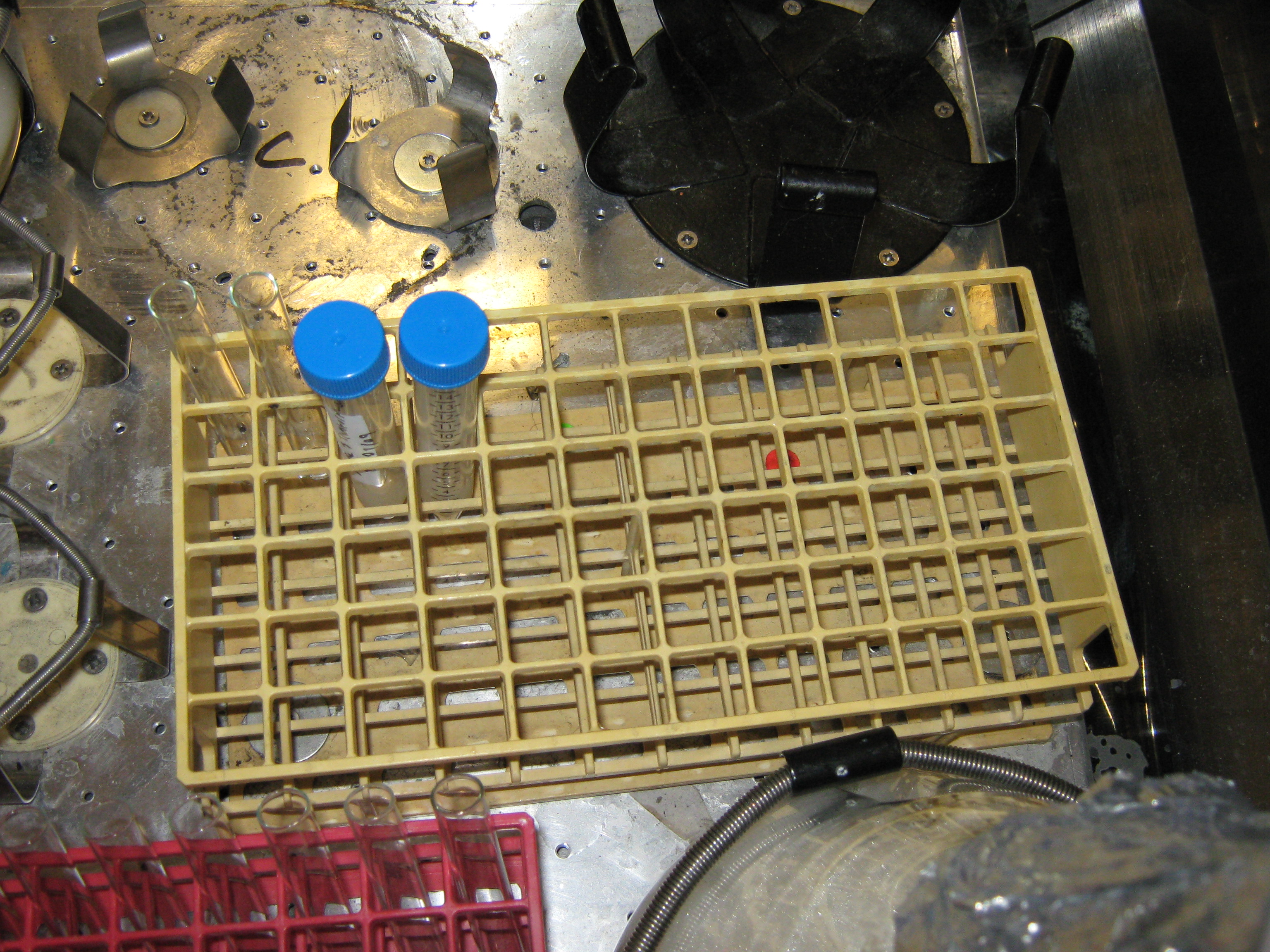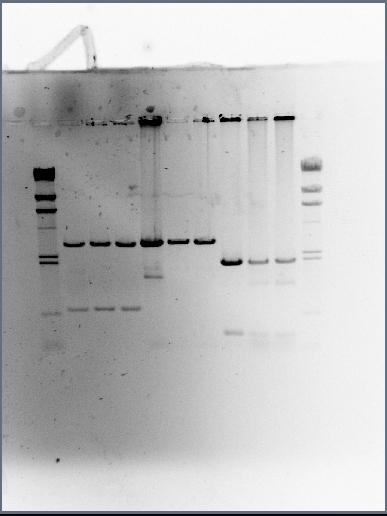Team:Newcastle/Labwork/29 July 2009
From 2009.igem.org
Formal Lab Session - 29th July 2009
Introduction
In yesterday's lab session we conducted mini-preps for three sets of JM109 E. coli cells which contained BioBricks BBa_C0056, BBa_B1002 and BBa_R0077 (seen as we picked three colonies for each of the BioBrick trasnformants there was a total of nine mini-preps conducted). A sample of these prepped plasmids were then run on agarose gel; although the undigested plasmid samples couldn't determine whether the DNA was in fact the BioBrick incorporated within the correct plasmid the gel certainly showed that the samples were consistent (trulin out contamination).
The next step in the lab plan is to digest samples of these 9 mini-preps and then run these fragments on agarose gel by DNA Gel Electrophoresis. As well as this, the team needs to consider another attempt at transforming E. coli with the BioBricks BBa_C0077 and BBa_C0076 (the transformations which didn't yield colonies on LB + ampicillin plates). In addition the team needs to start to freeze down cells which will probably be needed in the future.
Practical Outline
Before the day is out the team needs to carry out the following:
- Carry out a restriction digest on the 9 mini-preps using enzymes EcoRI and PstI
- Run the digest products on gel through DNA Gel Electrophoresis.
- Transform JM109 E. coli cells with BioBricks BBa_C0077 and BBa_C0076
- Inoculate tubes containing 5ml LB (+ antibiotic) with the cells that are to be frozen down
Procedure
Restriction Digests
The restriction enzyme digests were conducted by firstly inserting the following components to Eppendorf tubes:
| BBa_C0056 | BBa_B1002 | BBa_R0077 | ||
|---|---|---|---|---|
| DNA (ul) | 1 | 10 | 10 | |
| Water (ul) | 15 | 6 | 6 | |
| Buffer (ul) | 2 | 2 | 2 | |
| EcoRI (ul) | 1 | 1 | 1 | |
| PstI (ul) | 1 | 1 | 1 |
A couple of points to make:
- Three colonies were taken from each plate containing BioBrick transformants so there is a total of 9 mini-prep digests - 3 BBa_C0056 digests, 3 BBa_B1002 digests and 3 BBa_R0077 plasmid digests.
- It was decided that only 1ul of BBa_C0056 would be digested (as opposed to 10ul of DNA) - this is because the gel produced the previous day showed that the DNA concentration of BBa_C0056 mini-prep was really high.
The substances were added in the following order: 1) DNA, 2)Water, 3)Buffer, 4)Enzyme
Because the components of the digest were pipetted against the sides of the 9 Eppendorf tubes, the tubes were spun down for a pulse to mix the contents together. The 9 Eppendorf tubes were then placed in the 37C water bath for 1 hour.
DNA Gel Electrophoresis
The DNA samples were the prepared in the way suggested by the DNA Gel Electrophoresis protocol (i.e. 9ul of restriction digest solution and 1ul of loading buffer/dye) and loaded into the 0.8% agarose gel (along with the HindIII DNA ladder). DNA gel electrophoresis was allowed to commence for 40 minutes under 100 volts. Once this procedure was accomplished, the gel was analysed under UV light by GelDoc. The photograph can be seen under the 'Results' section.
Transforming JM109 cells with BBa_C0077 and BBa_C0076
The team are going to reattempt the transformations of JM109 cells with BBa_C0077 and BBa_C0076 - this time, we will plate the transformants on LB + kanamycin plates and NOT LB + ampicillin!. Again the team followed the protocol set by Promega and only made a few changes:
- Step 3 - instead of adding 100ul of Competent Cells to the culture tubes, only 50ul was transferred.
- Step 4 - the DNA added to the competent cells was 1ul instead of 10ul (this is because we only had approximately 2-3ul of DNA remaining!)
- Step 8 - the media used to grow the transformant cells was LB and not SOC
Once the transformation process was completed, both sets of E. coli cells (containing BBa_C0077 and BBa_C0076) were plated out on kanamycin LB plates. These plates were then transferred to the 37C incubator for overnight growth.
Preparing cells for freezing down
The cells to be frozen down included the following: E. coli containing RFP, E. coli containing GFP, JM109 E. coli containing BBa_C0056, JM109 E. coli containing BBa_B1002, JM109 E. coli cells containing BBa_R0077 and E. coli cells containing pMUTIN4 plasmid.
6 tubes were labelled and to each of them, 5ml of LB was added. Anti-biotics were then added to the appropriate tubes (25ul of each antibiotic is the volume used for 5ml of LB) and the colonies added to the right tubes. The tubes were laid out as follows:
| Tube Number | Cells to be frozen down | LB (ul) | Antibiotic 1 | Antibiotic 2 | |
|---|---|---|---|---|---|
| 1 | E. coli + RFP | 6 | Ampicillin (25ul) | ------- | |
| 2 | E. coli + GFP | 6 | Ampicillin (25ul) | ------- | |
| 3 | JM109 E. coli + BBa_C0056 | 6 | Ampicillin (25ul) | ------- | |
| 4 | JM109 E. coli + BBa_B1002 | 6 | Ampicillin (25ul) | Kanamycin (25ul) | |
| 5 | JM109 E. coli + BBa_R0077 | 6 | Ampicillin (25ul) | ------- | |
| 6 | E. coli + pMUTIN4 | 6 | Ampicillin (25ul) | ------- |
Once the inoculations were completed the tubes were placed in the 37C incubator for overnight growth; the strains will be frozen down tomorrow. Meanwhile a record of the cells to be frozen was kept in the TPA catalogue
Results
These are the wells:
- Lane 1 = blank
- Lane 2 = HindIII DNA ladder
- Lane 3 = BBa_C0056 mini-prep (from colony 1) digest
- Lane 4 = BBa_C0056 mini-prep (from colony 2) digest
- Lane 5 = BBa_C0056 mini-prep (from colony 3) digest
- Lane 6 = BBa_B1002 mini-prep (from colony 1) digest
- Lane 7 = BBa_B1002 mini-prep (from colony 2) digest
- Lane 8 = BBa_B1002 mini-prep (from colony 3) digest
- Lane 9 = BBa_R0077 mini-prep (from colony 1) digest
- Lane 10 = BBa_R0077 mini-prep (from colony 2) digest
- Lane 11 = BBa_R0077 mini-prep (from colony 3) digest
- Lane 12 = HindIII DNA ladder
BBa_C0056 Mini-Prep digests
It can be seen the first set of three digested DNA samples, BBa_C0056, looks very consistent in band layout. The smaller fragment lies very near the 564bp fragment of the HindIII ladder (in fact is is slightly larger) and this size corresponds to the size of the cI repressor, which is 636bp. This means that this insert is correct.
The larger fragment lies above the 2322bp fragment of the ladder and could correspond to the pSB1A2 plasmid backbone which is 2079bp according to the Parts Registry. However the pSB1A2 plasmid which carries this BioBrick also has kanamycin resistance so the extra gene could be the reason why our backbone fragment is larger.
The kanamycin resistance gene is 814bp so if we add that number to the 2027bp pSB1A2 fragment, we get a plasmid backbone of 2893bp - this corresponds to what is seen in the gel.
BBa_B1002 Mini-Prep digests
The larger fragment in all three wells can be seen to be larger than the 2322bp fragment of the HindIII ladder (and also slightly larger than the fragment caused by the pSB1A2 backbone in the BBa_C0056 samples). The plasmid backbone on which BBa_B1002 is found is pSB1AK3 which is 3189bp in size therefore it can be said that the correct backbone has been transformed.
Meanwhile the BioBrick we are expecting to see is really small (a 6bp stem, 4nt loop) so it won't be detected within the gel. The band which can be seen in lane 4 (i.e. the digest of BBa_B1002 mini-prep from colony 1) is probably the result of a partial digest.
BBa_R0077 Mini-Prep digests
The expected length of the BioBrick BBa_R0077 is 231bp. In the gel it can be seen that there are a row of faint bands that can be seen (in the last three wells of DNA sample) which lie below the 564bp fragment of the HindIII ladder. This has to be the desired BioBrick.
The larger fragment seen in the 3 digested mini-prep samples of BBa_R0077 lies around the region of the 2027bp band of the HindIII ladder. This is to be expected as the plasmid backbone is pSB1A2 which measures 2079bp. This time the pSB1A2 contains no kanamycin resistance (just ampicillin resistance) so the bp size displayed in the Parts Registry is the exact size of this backbone fragment.
Conclusion
The three mini-preps that were transformed in E. coli JM109 cells are correct; when the restriction enzymes EcoRI and PstI are applied, the correct sized fragments appear.
|
| |||||||||||||||||||||||||||||||||||||||||||||||||||||||||||||||||||||||||||||||||||||||||||||||||
|
| |||||||||||||||||||||||||||||||||||||||||||||||||||||||||||||||||||||||||||||||||||||||||||||
News
Events
- 20 – 21 June 2009 - Europe workshop (London)
- 23 – 24 June 2009 - UK iGEM meetup (Edinburgh)
- 23 October Practice Presentation (Newcastle)
- 23 October T-shirts are ready
- 27 October Practice Presentation (Sunderland)
- 27 October Poster is ready
- 30 October – 2 November 2009 - Jamboree (Boston)
Social Net
 "
"



